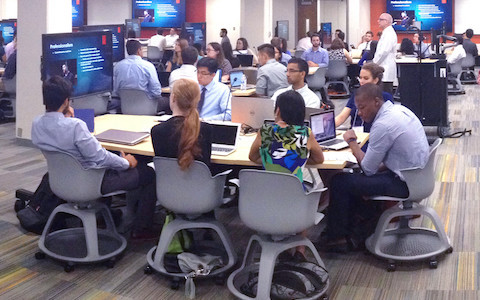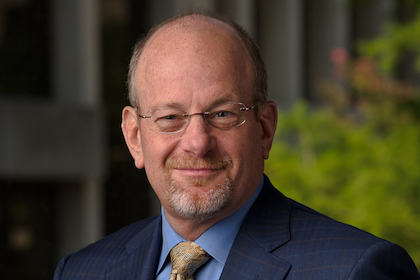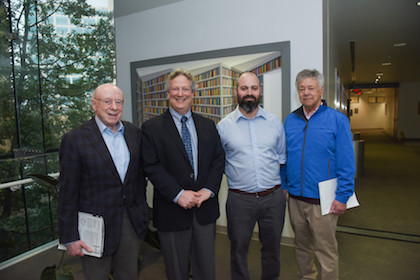Students quickly advancing through integrated medical curriculum
By Valerie Garcia

Katherine Pouns and Reed Macy, co-Presidents for the Class of 2019, will always remember their first day of instruction at UT Southwestern Medical School.
“It was very special,” Ms. Pouns said. “When Nobel Laureate Dr. Michael Brown spoke about the attributes of being a good physician – that was an ‘awe’ moment.”
Mr. Macy nodded in agreement, “It was spectacular,” he said.
Ms. Pouns and Mr. Macy are two of 239 students who recently completed the inaugural year of UT Southwestern’s new medical school curriculum.
“The first semester was rigorous and I learned a lot in the classes,” Mr. Macy said. “I’m still digesting it, I’m still figuring things out. This new curriculum is fast paced and our peers are really sharp.”
The first semester – heavy on core science classes (Basic Science Foundation) as well as labs – included biochemistry, anatomy, and histology. Bookwork and labs soon gave way to systemic instruction.
“The second semester marked the beginning of our Integrated Medicine curriculum,” Ms. Pouns said. “Previously, the curriculum had a separate physiology course in the first semester. Students would learn the physiology at that time, and then would begin learning pathology by organ block (cardio, renal, GI) in the second year.
“Our curriculum completely changes that system. Instead of having a separate first-year physiology block and pathology organ blocks in the second year, we begin the system/organ blocks the second semester of year one. Each system block of our Integrated Medicine curriculum is four weeks, with the first week focusing on physiology and the other weeks focusing on pathology and other topics.”
Each Integrated Medicine block has incorporated quizzes, TBLs, simulation sessions, and gross pathology sessions that provide different ways to learn the material, Ms. Pouns explained. The simulation sessions are new to the curriculum, and are hands-on team-based case studies.
In 2013. Dr. J. Gregory Fitz, Executive Vice President for Academic Affairs and Provost, and Medical School Dean, formed a committee of five academic leaders to develop comprehensive change to the curriculum. Since the school opened in 1943, the curriculum has evolved with the changing landscape of medicine, but it had not implemented a complete overhaul until 2015.
“Much of our outstanding curriculum has been taught before, but rearranged for integration and efficiency,” said Dr. Dennis Burns, Professor of Pathology and one of the academic committee members.
Systemic instruction, for instance, results in many more faculty members presenting to the students.
“We’ve had M.D.s as well as Ph.D.s teaching us,” Mr. Macy said. “You are hearing two different languages, and the faculty is reviewing and revising our material, doing a good job of making sure that we are effectively digesting the subject matter as opposed to just testing on it.
“In the first year we’ve had more than 100 Professors present. That’s the great thing about UT Southwestern – there’s an ocean of resources to draw from.”
The new curriculum shortens the pre-clerkship period to 18 months, allowing students to begin clerkships six months earlier, where they receive real life experience in the hospital setting. By mid-summer 2015, the academic committee began developing the second phase of the new curriculum, which launches in January 2017.
“By integrating the classes, we were able to eliminate unnecessary redundancies,” said Dr. James Stull, Chairman of Physiology and leader of the academic committee. Dr. Stull said that a highlight of the new curriculum is the inclusion of a Team Based Learning (TBL) environment.
Team Based Learning: Developing more teamwork and collaboration
In 2015, UT Southwestern gutted the second floor of the South Campus Library and transformed it from an underused space into the largest TBL Center of its kind in the United States. A key component of the medical school’s new curriculum, the $6 million state-of-the-art facility accommodates up to 270 students. The space includes 42 tables, each with seven chairs with one chair reserved for the occasional faculty mentor for Academic Colleges. Each table has a widescreen monitor, a high fidelity microphone, and a portal for students to plug in their laptops.
The TBL format encourages active learning and participation among the six students in each group, who remain together for 18 months. A typical TBL session opens with a quiz on pre-assigned reading material, which is first taken by each student, and then taken by each group. The remainder of the session focuses on a case study for the groups to work together to solve and then present to the class.
Gene Hu, curriculum representative for the Class of 2019, said the TBL exercises are a work still in progress. Increased utilization by future Medical School classes will occur naturally as the library of sessions expands, he said.
“The recent TBLs have succeeded in creating an environment to engage students and challenge them with very relevant clinical pictures,” Mr. Hu said.
The new curriculum also dropped the classic sliding grade scale to that of a pass or fail for the final course grade. The idea is to alleviate GPA anxiety, therefore removing the competitiveness among students and fostering an environment where good ideas and information are shared. Students are still graded for different activities so that they understand their level of learning relative to the class average.
Part of Mr. Hu’s role as curriculum representative is to gather and present his classmates’ feedback to the curriculum directors. Mr. Hu said that he’s impressed with the faculty’s sincerity and receptiveness to the feedback and that he’s already seen improvements implemented into the curriculum.
“One of the many reasons I came to UT Southwestern was for this new curriculum,” said Mr. Hu. “I want to serve my classmates by proactively foreseeing hiccups and then working with the course directors to iron them out. The improvements derived from the contributions of this class will benefit future generations of UT Southwestern students, and the faculty has been open and helpful in listening to us and making adjustments both retroactively and proactively to make this transition in curriculum as smooth as possible.”
Mr. Macy said that student observations were welcomed.
“We have to be the squeaky wheels because we’re the first group going through this new instruction,” he said. “For instance, we have reduced pre-clinical lecture time in comparison with the previous curriculum. Initially, this meant many lectures were running over and repeating or cutting into subsequent lectures. We have terrific curriculum reps and feedback groups that have relayed such issues to the faculty and administration, ‘This is working, but this part isn’t.’ And the faculty has been very receptive to our feedback.”
Ms. Pouns said the Class of 2019 has adopted well to its pioneering status.
“The second semester has done a much better job of integrating the material. The schedule has been much more predictable with the set instructional blocks, and this allows students to get in a rhythm of how to pace their study time,” she said. “I think many of the challenges arose in the first semester, when the material comes very quickly, the material is difficult, our schedule is time intensive, while at the same time students are still transitioning from an undergraduate to a medical school mentality. I know the administration has received and acted on our feedback, doing things like tweaking the first year to make the lecture and exam schedule more manageable.”
Dr. Burns said that students appear to be adapting well to the new curriculum. “We recognize that this curriculum, like all good curricula, is a work in progress, and we are looking to make it even better as we move forward.”
Dr. Stull said, “UT Southwestern has a long history of being outstanding in medical education. In developing and implementing the new curriculum, the faculty has really stepped up to the challenge and has been remarkable. We’re improving the experience and education for our students, which we hope in turn will make them better doctors.”
###
Dr. Brown, a Regental Professor and Director of the Erik Jonsson Center for Research in Molecular Genetics and Human Disease, holds The W.A. (Monty) Moncrief Distinguished Chair in Cholesterol and Arteriosclerosis Research, and the Paul J. Thomas Chair in Medicine.



